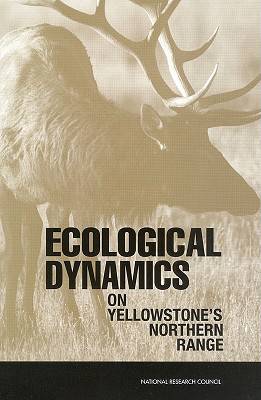
- Afhalen na 1 uur in een winkel met voorraad
- Gratis thuislevering in België vanaf € 30
- Ruim aanbod met 7 miljoen producten
- Afhalen na 1 uur in een winkel met voorraad
- Gratis thuislevering in België vanaf € 30
- Ruim aanbod met 7 miljoen producten
Zoeken
Ecological Dynamics on Yellowstone's Northern Range
National Research Council, Division on Earth and Life Studies, Board on Environmental Studies and Toxicology, Committee on Ungulate Management in Yellowstone National Park
Paperback | Engels
€ 37,95
+ 75 punten
Omschrijving
Ecological Dynamics on Yellowstone's Northern Range discusses the complex management challenges in Yellowstone National Park. Controversy over the National Park Service's approach of "natural regulation" has heightened in recent years because of changes in vegetation and other ecosystem components in Yellowstone's northern range. Natural regulation minimizes human impacts, including management intervention by the National Park Service, on the park ecosystem. Many have attributed these changes to increased size of elk and other ungulate herds.
This report examines the evidence that increased ungulate populations are responsible for the changes in vegetation and that the changes represent a major and serious change in the Yellowstone ecosystem. According to the authors, any human intervention to protect species such as the aspen and those that depend on them should be prudently localized rather than ecosystem-wide. An ecosystem--wide approach, such as reducing ungulate populations, could be more disruptive. The report concludes that although dramatic ecological change does not appear to be imminent, approaches to dealing with potential human--caused changes in the ecosystem, including those related to climate change, should be considered now. The need for research and public education is also compelling.
This report examines the evidence that increased ungulate populations are responsible for the changes in vegetation and that the changes represent a major and serious change in the Yellowstone ecosystem. According to the authors, any human intervention to protect species such as the aspen and those that depend on them should be prudently localized rather than ecosystem-wide. An ecosystem--wide approach, such as reducing ungulate populations, could be more disruptive. The report concludes that although dramatic ecological change does not appear to be imminent, approaches to dealing with potential human--caused changes in the ecosystem, including those related to climate change, should be considered now. The need for research and public education is also compelling.
Specificaties
Betrokkenen
- Auteur(s):
- Uitgeverij:
Inhoud
- Aantal bladzijden:
- 198
- Taal:
- Engels
Eigenschappen
- Productcode (EAN):
- 9780309083454
- Verschijningsdatum:
- 1/02/2002
- Uitvoering:
- Paperback
- Formaat:
- Trade paperback (VS)
- Afmetingen:
- 166 mm x 233 mm
- Gewicht:
- 331 g

Alleen bij Standaard Boekhandel
+ 75 punten op je klantenkaart van Standaard Boekhandel
Beoordelingen
We publiceren alleen reviews die voldoen aan de voorwaarden voor reviews. Bekijk onze voorwaarden voor reviews.











